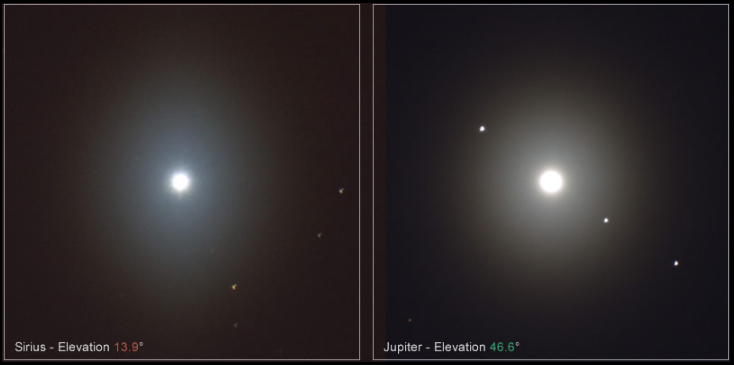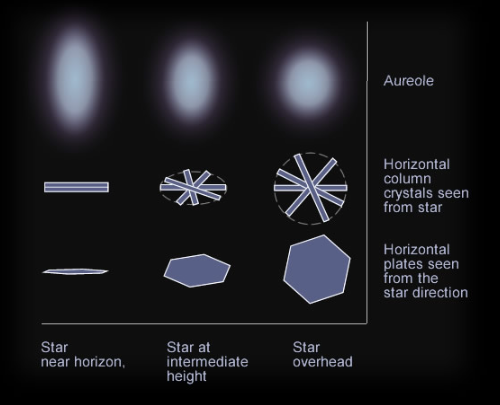OPOD - Oval and not so oval aureoles
OPOD - Oval and not so oval aureoles
Aureoles, those captivating rings of light around stars or planets, have long fascinated scientists and sky observers. These ethereal phenomena are formed when small particles in the atmosphere, such as water droplets, ice crystals, aerosols, dust, and even pollen, diffract sunlight. While most aureoles are circular in shape, there are instances where they appear elongated, specifically around bright planets. This peculiar elongation raises questions about the nature of the diffracting objects and their orientation.
One hypothesis suggests that the elongated aureoles may be caused by horizontally elongated ice crystals, similar to those that form halos. These ice crystals, typically plate or column-shaped, tend to appear horizontally elongated when illuminated by sun or starlight near the horizon. However, when illuminated by near-vertical rays, they tend to look symmetrical. As a result, their aureoles around stars or planets should transition from being vertically elongated near the horizon to becoming circular near the zenith.
To investigate this hypothesis, Peter Rosen of Stockholm captured near-simultaneous images of aureoles around stars and planets at different altitudes. Comparing the aureoles around Sirius, a star low in the sky, and Jupiter, half way to the zenith, Rosen noticed a distinct difference in their shapes. The Sirius aureole appeared more elongated than Jupiter's, indicating that the diffracting objects causing these aureoles may indeed be horizontally elongated ice crystals.
These findings support the notion that horizontally elongated ice crystals can generate vertically elongated aureoles around stars and planets when they are near the horizon. As the angle of illumination changes and the crystals appear more symmetrical when viewed from near-vertical rays, their aureoles become circular. The images captured by Rosen provide visual evidence for this hypothesis, confirming a predicted behavior of these ice crystals.
While this observation is significant, more research and analysis are needed to fully understand the mechanisms behind these oval and not so oval aureoles. By studying these atmospheric optics phenomena, scientists can gain valuable insights into the nature of ice crystals and their interactions with sunlight. This knowledge can further our understanding of atmospheric conditions and contribute to a better understanding of Earth's climate system.
To capture the images, Rosen utilized a Canon EOS5D MkII (full frame) camera mounted on a WO FLT-110 refractor with a 4x TeleVue Powermate. These high-quality images provide detailed visual documentation of the aureoles and contribute to the growing body of knowledge in atmospheric optics.
In conclusion, the study of oval and not so oval aureoles sheds light on the fascinating world of atmospheric optics. By investigating the shape and characteristics of these aureoles, scientists can gain valuable insights into the nature of diffracting particles in the atmosphere, particularly horizontally elongated ice crystals. Peter Rosen's images provide compelling evidence for the presence of such ice crystals and their impact on the shape of aureoles. With further research and analysis, we can continue to unravel the mysteries of these captivating atmospheric phenomena.

Oval & not so oval aureoles
Peter Rosen of Stockholm generously answered my plea for near simultaneous images of aureoles around stars or planets at high and low altitudes.
At left is Sirius, low in the sky. At right is Jupiter and its moons half way to the zenith.
The Sirius aureole is more elongated than Jupiter's. Mouse over the image for intensity contours.
Why do this?
Aureoles (see also thumbnails below) are formed by small objects, water droplets, ice crystals, aerosol, dust and even pollen, diffracting sunlight. When the particles are fairly uniform sized the aureole develops into a multi-ringed corona.
Most aureoles are circular. Mysteriously, some small aureoles around bright planets are vertically elongated. That implies that the diffracting objects are horizontally elongated - they are certainly not water droplets and the aureoles are the wrong size to be from airborne pollen.
A possibility is that the diffractors are oriented plate or column shaped ice crystals, the type that also form halos. These crystals appear, on average, to be horizontally elongated to sun or starlight from near the horizon. But, on average, they look symmetrical when illuminated by near vertical rays. Their aureoles around stars or planets should therefore be vertically elongated near the horizon changing to circular near the zenith.
Peter Rosen's images support this hypothesis.
More observations and analyses are needed - but it is good to see a prediction confirmed.
Images were taken with a Canon EOS5D MkII (full frame) mounted on a WO FLT-110 refractor with a 4x TeleVue Powermate.
Images ©Peter Rosen, shown with permission.

Diffraction by ice crystals in the air.
If the crystals are sufficiently large they will be aerodynamically oriented as they drift downwards relative to local air currents.
To light from a relatively low star the crystals - hexagonal plates or columns - appear on average to be horizontally elongated. The resulting scattering and diffraction creates a vertically elongated aureole.
The crystals appear - on average - to be increasingly circular to light from stars or planets higher in the sky. They then generate more circular aureoles.
Note: this article has been automatically converted from the old site and may not appear as intended. You can find the original article here.
Reference Atmospheric Optics
If you use any of the definitions, information, or data presented on Atmospheric Optics, please copy the link or reference below to properly credit us as the reference source. Thank you!
-
<a href="https://atoptics.co.uk/blog/opod-oval-and-not-so-oval-aureoles/">OPOD - Oval and not so oval aureoles</a>
-
"OPOD - Oval and not so oval aureoles". Atmospheric Optics. Accessed on December 19, 2024. https://atoptics.co.uk/blog/opod-oval-and-not-so-oval-aureoles/.
-
"OPOD - Oval and not so oval aureoles". Atmospheric Optics, https://atoptics.co.uk/blog/opod-oval-and-not-so-oval-aureoles/. Accessed 19 December, 2024
-
OPOD - Oval and not so oval aureoles. Atmospheric Optics. Retrieved from https://atoptics.co.uk/blog/opod-oval-and-not-so-oval-aureoles/.